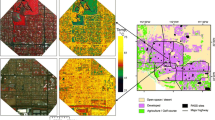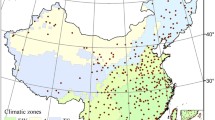Abstract
The urban heat island (UHI) phenomenon is a common environmental problem in urban landscapes which affects both climatic and ecological processes. Here we examined the diurnal and seasonal characteristics of the Surface UHI in relation to land-cover properties in the Phoenix metropolitan region, located in the northern Sonoran desert, Arizona, USA. Surface temperature patterns derived from the Advanced Spaceborne Thermal Emission and Reflection Radiometer for two day-night pairs of imagery from the summer (June) and the autumn (October) seasons were analyzed. Although the urban core was generally warmer than the rest of the area (especially at night), no consistent trends were found along the urbanization gradient. October daytime data showed that most of the urbanized area acted as a heat sink. Temperature patterns also revealed intra-urban temperature differences that were as large as, or even larger than, urban–rural differences. Regression analyses confirmed the important role of vegetation (daytime) and pavements (nighttime) in explaining spatio-temporal variation of surface temperatures. While these variables appear to be the main drivers of surface temperatures, their effects on surface temperatures are mediated considerably by humans as suggested by the high correlation between daytime temperatures and median family income. At night, however, the neighborhood socio-economic status was a much less controlling factor of surface temperatures. Finally, this study utilized geographically weighted regression which accounts for spatially varying relationships, and as such it is a more appropriate analytical framework for conducting research involving multiple spatial data layers with autocorrelated structures.








Similar content being viewed by others
References
Arnfield AJ (2003) Two decades of urban climate research: a review of turbulence, exchanges of energy and water, and the urban heat island. Int J Climatol 23:1–26
Baker LA, Brazel AJ, Selover N et al (2002) Urbanization and warming of Phoenix (Arizona, USA): impacts, feedbacks, and mitigation. Urban Ecosyst 6:183–203
Balling RC, Brazel SW (1988) High-resolution surface temperature patterns in a complex urban terrain. Photogramm Eng Remote Sens 54:1289–1293
Balling RC, Brazel SW (1989) High-resolution nighttime temperature patterns in Phoenix. J Ariz-Nev Acad Sci 23:49–53
Bonan GB (2002) Ecological climatology: concepts and applications. Cambridge university press, Cambridge
Brazel A, Selover N, Vose R et al (2000) The tale of two climates—Baltimore and Phoenix urban LTER sites. Clim Res 15:123–135
Brazel A, Gober P, Lee SJ et al (2007) Determinants of changes in the regional urban heat island in metropolitan Phoenix (Arizona, USA) between 1990 and 2004. Clim Res 33:171–182
Carlson TN, Arthur ST (2000) The impact of land use—land cover changes due to urbanization on surface microclimate and hydrology: a satellite perspective. Global Planet Change 25:49–65
Carnahan WH, Larson RC (1990) An analysis of an urban heat sink. Remote Sens Environ 33:65–71
Fortin MJ, Dale MRT (2005) Spatial analysis: a guide for ecologists. Cambridge University Press, Cambridge
Fotheringham S, Brundson C, Charlton M (2002) Geographically weighted regression: the analysis of spatially varying relationships. Wiley, Chichester
Gallo KP, McNab AL, Karl TR et al (1993a) The use of a vegetation index for assessment of the urban heat island effect. Int J Remote Sens 14:2223–2230
Gallo KP, McNab AL, Karl TR et al (1993b) The use of NOAA AVHRR data for assessment of the urban heat island effect. J Appl Meteorol 32:899–908
Gillespie AR, Matsunaga T, Rokugawa S et al (1998) Temperature and emissivity separation from advanced spaceborne thermal emission and reflection radiometer (ASTER) images. IEEE Trans Geosci Remote Sens 36:1113–1126
Gillies RR, Cui J, Carlson TN et al (1997) A verification of the ‘triangle’ method for obtaining surface soil water content and energy fluxes from remote measurements of the normalized difference vegetation index (NDVI) and surface radiant temperature. Int J Remote Sens 18:3145–3166
Golden J (2004) The built environment induced urban heat island effect in rapidly urbanizing arid regions—a sustainable urban engineering complexity. Environ Sci 1:321–349
Goldreich Y (1985) The structure of the ground-level heat island in a central business district. J Appl Meteorol 24:1237–1244
Grimm N, Faeth S, Golubiewski N et al (2008) Global change and the ecology of cities. Science 319:756–760
Grimmond CSB, Oke TR (2002) Turbulent heat fluxes in urban areas: observations and a local-scale urban meteorological parameterization scheme (LUMPS). J Appl Meteorol 41:792–810
Grossman-Clarke S, Zehnder JA, Stefanov WL et al (2005) Urban modifications in a mesoscale meteorological model and the effects on near-surface variables in an arid metropolitan region. J Appl Meteorol 44:1281–1297
Guhathakurta S, Gober P (2007) The impact of the Phoenix urban heat island on residential water use. J Am Plann Assoc 73:317–329
Hafner J, Kidder SQ (1999) Urban Heat Island modeling in conjunction with satellite-derived surface/soil parameters. J Appl Meteorol 38:448–465
Hartz DA, Prashad L, Hedquist BC et al (2006) Linking satellite images and hand-held infrared thermography to observed neighborhood climate conditions. Remote Sens Environ 104:190–200
Hsu SI (1984) Variation of an urban heat island in Phoenix. Prof Geogr 36:196–200
Huete AR, Jackson RD (1987) Suitability of spectral indices for evaluating vegetation characteristics on arid rangelands. Remote Sens Environ 23:213–232
Jauregui E (1993) Mexico City’s urban heat island revisited. Int J Climatol 9:169–180
Jenerette GD, Harlan SL, Brazel A et al (2007) Regional relationships between surface temperature, vegetation, and human settlement in a rapidly urbanizing ecosystem. Landscape Ecol 22:353–365
Jonsson P (2004) Vegetation as an urban climate control in the subtropical city of Gaborone, Botswana. Int J Climatol 24:1307–1322
Kato S, Yamaguchi Y (2007) Estimation of storage heat flux in an urban area using ASTER data. Remote Sens Environ 110:1–17
Kim HH (1992) Urban heat island. Int J Remote Sens 13:2319–2336
Lowry JH Jr, Ramsey RD, Boykin K et al (2005) The southwest regional gap analysis project: final report on land cover mapping methods. RS/GIS Laboratory, Utah State University, Logan (Utah. p. 50)
Lu D, Weng Q (2006) Spectral mixture analysis of ASTER images for examining the relationship between urban thermal features and biophysical descriptors in Indianapolis, Indiana, USA. Remote Sens Environ 104:157–167
Nasrallah HA, Brazel A, Balling RC Jr (1990) Analysis of the Kuwait city urban heat island. Int J Climatol 10:401–405
Neter J, Kutner MH, Nachtsheim CJ et al (1996) Applied linear statistical models. McGraw-Hill/Irwin, Boston
Nichol JE (1996) High-resolution surface temperature patterns related to urban morphology in a tropical city: a satellite-based study. J Appl Meteorol 35:135–146
Nichol JE (1998) Visualisation of urban surface temperatures derived from satellite images. Int J Remote Sens 19:1635–1637
Oke TR (1976) The distinction between canopy and boundary-layer heat islands. Atmosphere 14:268–277
Oke TR (1982) The energetic basis of the urban heat island. Quart J Royal Meteorol Soc 108:1–24
Oke TR (1997) Urban climates and global change. In: Perry A, Thompson R (eds) Applied climatology: principles and practices. Routledge, London, pp 273–287
Owen TW, Carlson TN, Gillies RR (1998a) An assessment of satellite remotely-sensed land cover parameters in quantitatively describing the climatic effect of urbanization. Int J Remote Sens 19:1663–1681
Owen TW, Carlson TN, Gillies RR (1998b) Remotely sensed surface parameters governing urban climate change. Int J Remote Sens 19:1663–1681
Pena J (2008) Relationships between remotely sensed surface parameters associated with the urban heat sink formation in Santiago, Chile. Int J Remote Sens 29:4385–4404
Quattrochi DA, Ridd MK (1998) Analysis of vegetation within a semiarid urban environment using high spatial resolution airborne thermal infrared remote sensing data. Atmos Environ 32:19–33
Roth M, Oke TR, Emery WJ (1989) Satellite-derived urban heat islands from three coastal cities and the utilization of such data in urban climatology. Int J Remote Sens 10:1699–1720
Ruddell DM, Harlan SL, Grossman-Clarke S et al (2009) Risk and exposure to extreme heat in microclimates of Phoenix, AZ. In: Showalter PS, Lu Y (eds) Geospatial techniques in urban hazard and disaster analysis. Springer, New York (in press)
Sandholt I, Rasmussen K, Andersen J (2002) A simple interpretation of the surface temperature/vegetation index space for assessment of surface moisture status. Remote Sens Environ 79:213–224
Souch C, Grimmond CSB (2006) Applied climatology: urban climate. Prog Phys Geogr 30:270–279
Spronken-Smith RA, Oke TR (1998) The thermal regime of urban parks in two cities with different summer climates. Int J Remote Sens 19:2085–2104
Stabler LB, Martin C, Brazel A (2005) Microclimates in a desert city were related to land use and vegetation index. Urban For Urban Green 3:137–147
Stefanov WL, Ramsey MS, Christensen PR (2001) Monitoring urban land cover change: an expert system approach to land cover classification of semiarid to arid urban centers. Remote Sens Environ 77:173–185
Stefanov W, Prashad L, Eisinger C et al (2004) Investigation of human modifications of landscape and climate in the Phoenix Arizona Metropolitan area using MASTER data. In: International archives of the photogrammetry, remote sensing, and spatial information sciences. ISPRS, Istanbul, Turkey, pp 1339–1347
Streutker DR (2002) A remote sensing study of the urban heat island of Houston, Texas. Int J Remote Sens 23:2595–2608
Taha H (1997) Urban climates and heat islands: albedo, evapotranspiration, and anthropogenic heat. Energy Build 25:99–103
Tucker CJ (1979) Red and photographic infrared linear combinations for monitoring vegetation. Remote Sens Environ 8:127–150
Upmanis H, Eliasson I, Lindqvist S (1998) The influence of green areas on nocturnal temperatures in a high latitude city (Göteborg, Sweden). Int J Climatol 18:681–700
Voogt JA (2002) Urban Heat Island. In: Douglas I (ed) Encyclopedia of global environmental change. Wiley, Chichester, pp 660–666
Voogt JA, Grimmond CSB (2000) Modeling surface sensible heat flux using surface radiative temperatures in a simple urban area. J Appl Meteorol 39:1679–1699
Voogt JA, Oke TR (2003) Thermal remote sensing of urban climates. Remote Sens Environ 86:370–384
Watkins R, Palmer J, Kolokotroni M (2007) Increased temperature and intensification of the urban heat island: implications for human comfort and urban design. Built Environ 33:85–96
Weng Q, Larson RC (2005) Satellite Remote Sensing of Urban Heat Islands: Current Practice and Prospects. In: Jensen RR, Gatrell JD, McLean DD (eds) Geo-spatial technologies in urban environments. Springer, Berlin, pp 91–111
Weng Q, Lu D, Schubring J (2004) Estimation of land surface temperature—vegetation abundance relationship for urban heat island studies. Remote Sens Environ 89:467–483
Wilson JS, Clay M, Martin E et al (2003) Evaluating environmental influences of zoning in urban ecosystems with remote sensing. Remote Sens Environ 86:303–321
Wu J (2008a) Making the case for landscape ecology: an effective approach to urban sustainability. Landsc J 27:41–50
Wu J (2008b) Toward a landscape ecology of cities: beyond buildings, trees, and urban forests. In: Carreiro MM, Song YC, Wu J (eds) Ecology, planning and management of urban forests: international perspectives. Springer, New York, pp 10–28
Xian G, Crane M (2006) An analysis of urban thermal characteristics and associated land cover in Tampa Bay and Las Vegas using Landsat satellite data. Remote Sens Environ 104:147–156
Acknowledgments
We appreciate the extensive help provided by Anthony Brazel and Susanne Grossman-Clarke. Chris Eisinger helped with ASTER data processing, and Chris M. Clark advised on data analyses. We thank David Iwaniec, Darrel Jenerette, and two anonymous reviewers for their helpful comments on an earlier version of the manuscript. This research was supported by the National Science Foundation under Grant No. DEB-0423704, Central Arizona-Phoenix Long-Term Ecological Research (CAP LTER) and under Grant No. BCS-0508002 (Biocomplexity/CNH). Any opinions, findings and conclusions or recommendation expressed in this material are those of the author(s) and do not necessarily reflect the views of the National Science Foundation (NSF).
Author information
Authors and Affiliations
Corresponding author
Rights and permissions
About this article
Cite this article
Buyantuyev, A., Wu, J. Urban heat islands and landscape heterogeneity: linking spatiotemporal variations in surface temperatures to land-cover and socioeconomic patterns. Landscape Ecol 25, 17–33 (2010). https://doi.org/10.1007/s10980-009-9402-4
Received:
Accepted:
Published:
Issue Date:
DOI: https://doi.org/10.1007/s10980-009-9402-4




